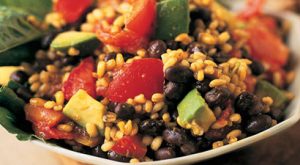Recipe For Health: Tips On How To Start A Healthy Recovery Diet Plan
 When you are recovering from an eating disorder, finding the right diet plan can be difficult.
When you are recovering from an eating disorder, finding the right diet plan can be difficult.
The decision-making process can be very overwhelming and can cause anxiety about how much to eat, when to eat and what to eat. Lori Lieberman, a dietitian and eating disorder counselor, remarks that when trying to recover:
We need to move from reliance on food rules to learning to trust our body and its signals; to differentiate physical need for fuel from our use of food to manage stress, boredom, loneliness, you name it. We need to move from analyzing and limiting our calorie intake, to trusting our hunger–regardless of what time it occurs.
Seven Helpful Tips for Starting a Recovery Diet Plan
- Give yourself permission to eat: Listen to what your body is saying – if you are craving food or if you are full – and learn to honor these two principles in order to help you on the road to recovery.
- Avoid replacing food with fluids: If you are using fluids such as a water because they contain no calories, remember that they also don’t contain much nutritional value.
- Be realistic: If you are embarking on this journey, be honest with yourself and think about what lines you are ready to cross and which you are not. Taking on more than you are ready for can turn into a real setback.
- Be patient: When you are trying to learn a new skill, or relearn an old one, it will take time to perfect your technique. Relearning to eat will take time, so be patient and be kind to yourself and your body.
- Avoid relying solely on willpower: Instead of trying to just “tough” it out, try having a mental plan. Having a loose schedule will help prepare you mentally to eat, but it will also allow you freedom to improvise and change things around.
- Avoid comparing yourself to others: Everyone’s body has different needs, and comparing your needs to the needs of somebody else can be dangerous. There are many variables that affect the needs of our bodies – height, muscle mass, activity levels and whether we need to be gaining or losing weight. Everyone is unique, and what works for one person may not work for you.
- Remember to ask for support: If you are going to begin this journey toward a healthier lifestyle, don’t do it alone. Ask for the support of your family and loved ones, and make sure that everyone is informed on your condition so that they can know how to help.
To start you on the right path, here is a recipe for Barley Black Bean Salad that is full of the nutrients you need without the overwhelming stress you don’t. This recipe combines a myriad of nutrients in one serving like protein, vegetables, healthy fats and soluble fiber. Soluble fiber, which can also be found in oatmeal, causes a slower rise in blood sugar and will keep you satisfied and full for a longer period of time. This type of fiber can also help in lowering blood cholesterol levels.
Barley Black Bean Salad
This recipe serves about 10 – perfect for a family, but you can cut the ingredients in half if you are cooking for only one or two.
Ingredients:
- Pearl barley
- Black beans, 2 cans, low salt, rinsed thoroughly
- Scallion, 3-4 large
- Red pepper, 1 large (more can’t hurt!)
- Cilantro, chopped, ¾ – 1 cup
- Olive oil, 2 Tbsp.
- Lime juice, 4 Tbsp.
- Salt, ¾ tsp
Cook barley. Place 6 cups water in large saucepan and bring to boil. Add 2 cups pearl barley. Return to boil. Reduce heat to low, cover 45 minutes or until barley is tender and liquid is absorbed. Makes about 6 to 7 cups. Rinse cooked barley. Add rinsed beans and all other ingredients. Mix well. Refrigerate then serve.
Source: Drop It And Eat blog, The Huffington Post
 Eating Disorder Self Test. Take the EAT-26 self test to see if you might have eating disorder symptoms that might require professional evaluation. All answers are confidential.
Eating Disorder Self Test. Take the EAT-26 self test to see if you might have eating disorder symptoms that might require professional evaluation. All answers are confidential.